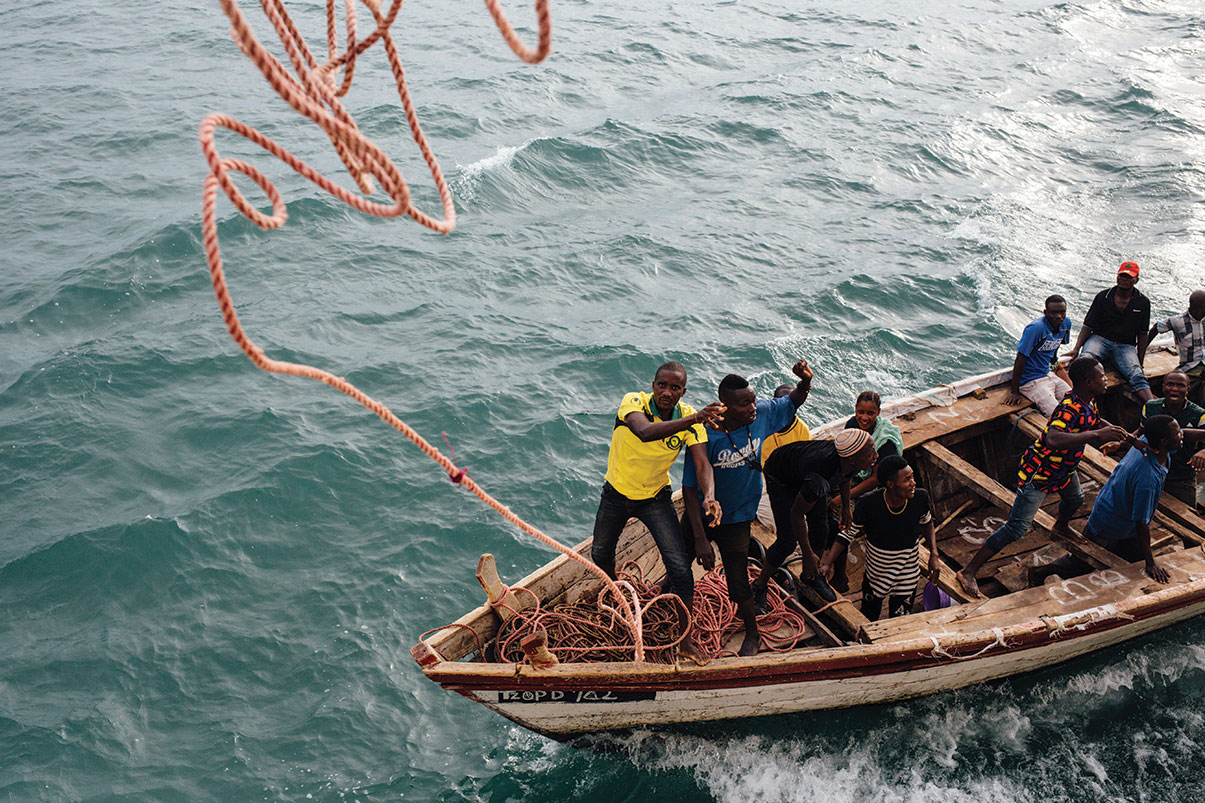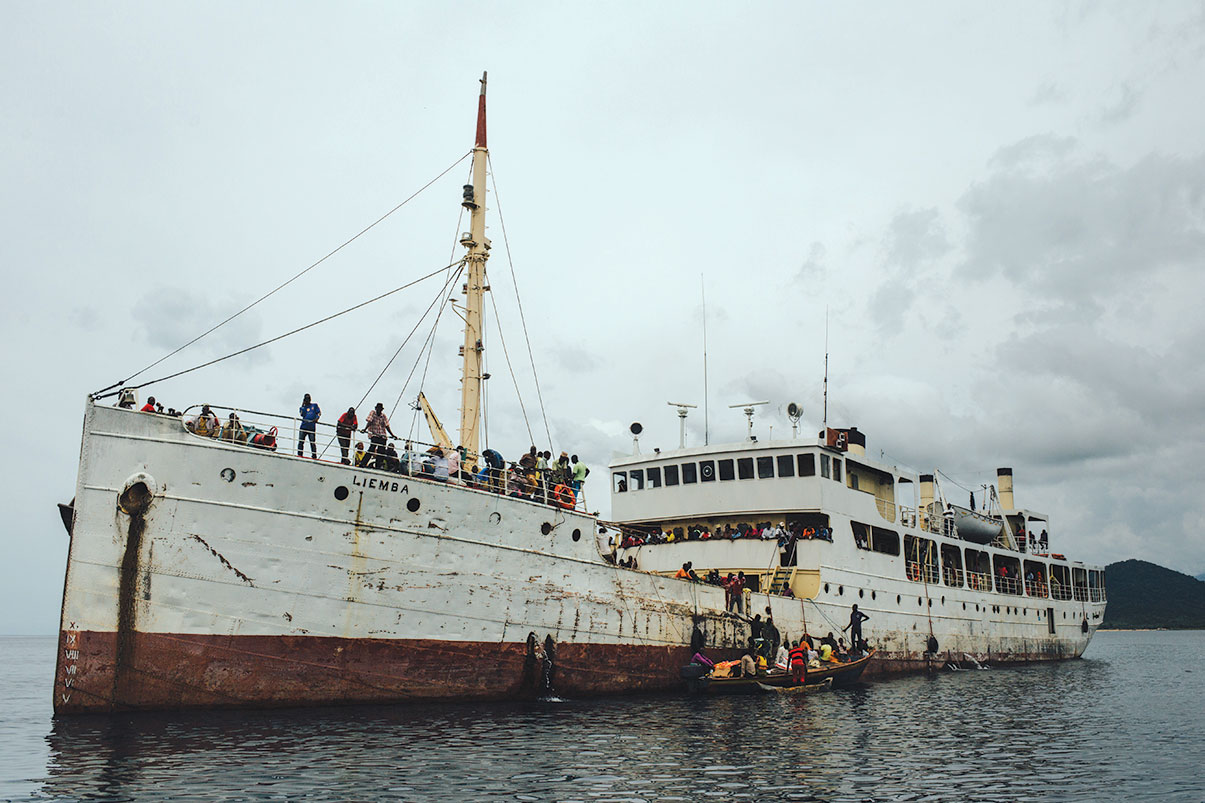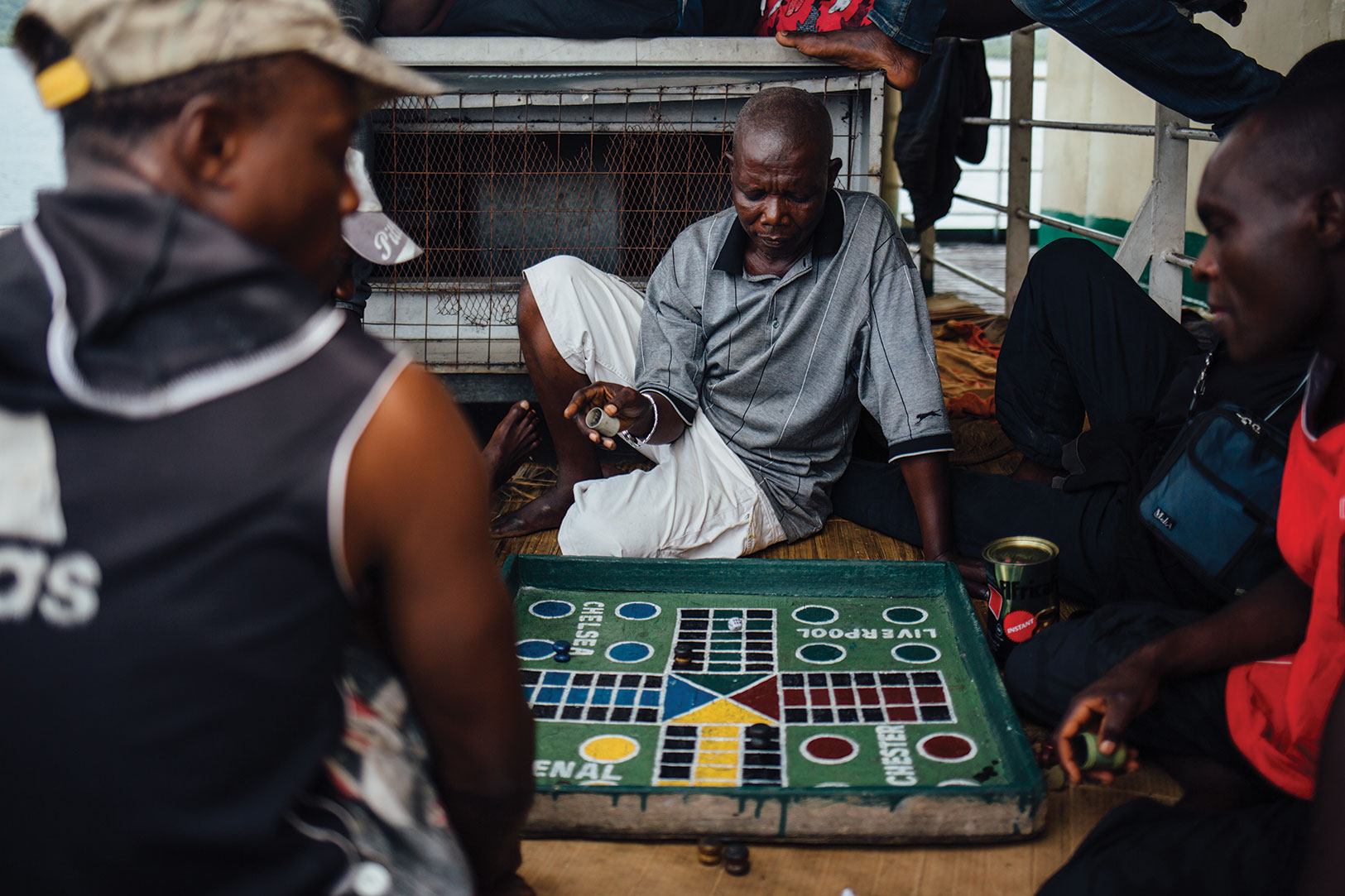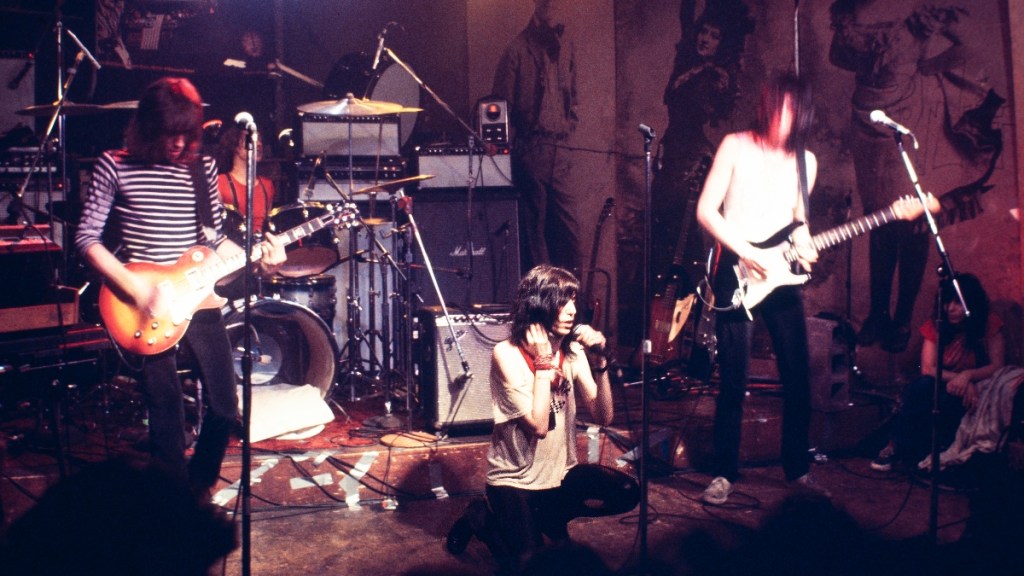This story appears in the March issue of VICE magazine. Click HERE to subscribe.
It was 10 PM when Alex, the photographer accompanying me on a three-day boat trip from Tanzania to Zambia this past January, saw rowboats gliding toward our ship, the historic MV Liemba. Ropes were tossed aboard as young men grappled up the side shouting in French and Swahili, crawling onto the main deck. The other passengers paused and took in the spectacle with great confusion. At least, that’s what I’m told. I had had already tucked myself in for the first night of our trip after post-dinner drinks had turned the night into a bawdy blur.
Videos by VICE
It turns out what unfolded was perfectly normal—I saw a similar scene unfold on the deck several other times over the course of our journey. We were at what must have been the first of 21 (no one was announcing the stops) on the boat’s 310-mile route from Kigoma, a big port town in central-west Tanzania, to Mplungu, a smaller port town in northwest Zambia. The Liemba docks just twice: once after departure, and then again at its final destination. The rest of the time, she anchors in the world’s second-deepest lake, Lake Tanganyika, and traders row out to do their business—cargo is unloaded, exchanges are made, people get off and on.
The MV Liemba, a repurposed German warship, is the oldest functioning passenger ferry on the planet, and its history embodies the ambitions of fallen colonial empires, the aftershocks of which Africa still feels. But more than that, she illuminates the unceasing hustle, vibrancy, and swelling capitalism that characterize much of the continent today. And, she’s fucking fun to ride.

The ferry docks just twice, but along the way, she anchors and passengers are allowed aboard from smaller boats.
According to Captain Titus Benjamin Mnyanyi, who has been with the ship for more than 25 years (and has moonlighted in about as many Liemba-related movies), every trip down the lake includes a handful of tourists—always in first class. The vast majority of the passengers on the Liemba are Africans (mainly Tanzanians) who take the boat because it’s the most accessible way to reach the shore towns that dot the southern half of the country. The nearest main road parallel to the Liemba‘s route is many miles away from the villages; terrible terrain renders the passage uncomfortable and time consuming. Tatu Kasim, an almond-eyed 22-year-old whom I met in the boat’s third-class hold, which was saturated with the fragrance of its pineapple cargo, said she can’t leave her village unless she takes a boat.
The Liemba sails twice a month, from Tanzania to Zambia and back again, and its deliveries (both passenger and payload) represent the biggest boom these otherwise isolated communities see each month. The ship can carry 600 people and up to 200 tons of cargo. Standard freight includes dagaa (small dried fish), wood (during our trip, around 40 eight-foot-long sticks jauntily angled overboard the vessel), soap, cases of juice, and—on this passage—thousands of pineapples.
“This ship is important,” explained Matthews Bala, who told me “I am African,” when I asked him where he was from. A first-class passenger with family in Tanzania and Congo, Bala brings dagaa from Tanzania to Congo, via Zambia. He buys the fish at a rate of 30,000 Tanzanian shillings (a little less than $14) per bucket. He boats them to Mplungu, and then trucks them to Congo. This is the most direct route he can take to do his business. There, the packing of the fish changes, as does the currency, but he said he sells 220 pounds for about $400. Besides business, Liemba passengers such as Janet Adam, who was traveling alone in third class to visit her sick father in Kasanga, the second to last stop, take the ship to visit family and friends.
On our first morning on the boat, I woke at sunrise. I’d planned to take a quick spin around the deck and return to the comfortable bottom bunk in my cabin, but as we passed the bosoms of the verdant Mahale Mountains, the purple and pink sky stopped me in my tracks. From there, I found myself in the dining car, where, over instant coffee and an omelet, I met Frank Espert, a middle-aged long-distance traveler and engineer from northern Germany. In an unabashedly preppy ensemble, the blue face of his watch picking up the stripes in his tailored shirt and navy sweater draped over his shoulders, Espert was riding the Liemba because he was interested in how things work in other countries—experiencing transport, he told me, is one of the best ways to learn a place.
The seminal book on the Liemba, Von Goetzen biz Liemba: Auf Reisen mit einem Jahrhundertschiff (From Goetzen to Liemba: When Traveling with a Century Ship), was written bySarah Paulus and Rolf G. Wackenbergin German, and Espert knows the ship’s history by heart: Meyer Werft, a famous ship-building company in Papenburg, Germany, constructed her in 1913. This was when Wilhem II was the emperor and Tanzania was German East Africa. At the time, Kigoma was a small fishing village, and the Germans had envisioned turning it into a major fishing port. She was assembled in Papenburg, and then disassembled in order to be shipped off to Tanzania in 5,000 wooden crates. The containers went by ship to Dar es Salaam, and were then carried west on foot and by train to Kigoma, where she was reconstructed.

The MV Liemba was constructed in Germany in 1913, fought in World War I, and was scuttled to the bottom of Lake Tanganyika before the British put her back into service in 1927.
Kaiser Wilhelm II was meant to visit his territory in Tanzania—the building in Kigoma that was erected for his stay is now used as government offices—but World War I changed everything. Africa endured WWI as European forces took up arms to defend their colonial turf: The Liemba launched about six months after the war’s outbreak in February 1915, and to protect German interests against the British, the ship was outfitted with cannons. She dominated Lake Tanganyika, providing a base to launch attacks against the Allied forces, making the water a central theater of fighting. The Germans invested money and time to diverting Allied interests to its East Africa Campaign. Hundreds of thousands of Africans died in the war—some estimate that more than 150,000 of them were laborers who’d been forced to support their colonial masters.
As the fighting progressed, Germany had to turn its focus to the British advances on land and scuttled the boat, sinking it to the bottom of the lake, so the country’s enemies wouldn’t get her. But once the war ended, locals showed the British where she was buried and helped the new colonizers bring her back to life. The Liemba resumed service in 1927 and has been operating almost nonstop ever since. The government took ownership after Tanzania became independent in 1961, and it has since been renovated twice, once in 1974 and again in 1993. Yusufu Shambi, the ship’s navigator, whose graying hair curls around the white baseball cap permanently resting on his head, said she’s up for renovations again this summer, though it seems nothing is confirmed. Among the updates will be air-conditioning for the third-class bunker—an effort to keep its passengers from coming up to the first-class deck. Shambi explained that Westerners have complained about the fluidity between the classes and “crowding” on the top deck.
This news depressed me because, to my mind, one of the best parts of the boat was the relaxed vibe. I’d expected our journey to feel like a trip down colonial lane, but instead, I felt that the Liemba had been properly, and satisfyingly, reclaimed by Africa.
I learned more of the ship’s recent history from Captain Mnyanyi, who started on the Liemba as a cadet. He is a hefty man with a friendly disposition, and was on the boat both times it was used to forcefully repatriate more than 75,000 Congolese refugees in 1997, and more than 100,000 between 2012 and 2014. He told me he felt no remorse about taking the people back, despite their having settled in Tanzania, because the war in their country had ended. He also captained the boat in 2015 when, over a one-and-a-half-month period, the United Nations High Commissioner for Refugees hired her to transport more than 50,000 Burundian refugees from Tanzania’s Kagunga beach down to camps outside Kigoma. “It was horrible,” recalled 26-year-old Luleka Mwendesha, a sailor. He made only nine of the 29 trips with the refugees, before he got sick. Mwendesha has seen at least three people die on the boat since he became a sailor three years ago. The nearest referral hospital is in Kigoma, and often people who need to go are brought aboard when the boat is heading north. Sometimes it’s too late.

Passenger movement between the cabins is relatively unrestricted, so the ship has an open and decidedly uncolonial vibe.
By the end of day two, Frank Espert, the middle-aged German, had loosened up. He was in a tank top, and whenever I asked how he was doing, he said, “Perfect.” I made up for crashing early on the first night by staying up late and knocking back Konyagi, a Tanzanian liquor, and Stoney, ginger beer, joining the mixture of sailors and travelers smoking joints up on the bow.
At noon, on what was meant to be the last day of our journey, I was glad to hear that we’d stay anchored in Kasanga, the second to last stop for the afternoon and evening, to allow more time for passengers to do their trade, and to avoid the $100 Zambian nighttime docking fee. I was all caught up on the boat’s history, so I took the opportunity to get to know the other passengers better, including Matthews Bala, the dagaa salesman. Eventually, he told me he is Congolese, but explained that he sees himself as an African first. For him, he clarified, it’s continent before country. “You Americans and French, you gave us freedom but not complete freedom,” he declared, adding that today both countries play a hand in instating dictators who have brought ruination to Africa. He instructed me to make a list that included Rwanda’s Paul Kagame, Congo’s Joseph Kabila, Burundi’s Pierre Nkurunziza, and Zimbabwe’s Robert Mugabe. Perhaps the shared history of past and present oppression had made him stand united—a continentalist, not a nationalist. “I love being African.”
Yusufu Shambi, the ship’s navigator, said he feels the same. All the people he’s met have given him a more realistic understanding of what happens around the world than watching the news, he thinks. He knows that, “If you want to live,” life is better in Africa than in America. I wondered if I should bring up war-torn countries like South Sudan and Somalia, but as we stood looking out, and the expanse swelled in me, I couldn’t help but agree.
UPDATE 3/6/17: Due to a reporting error, an earlier version of this article incorrectly stated the ship navigator’s name. It is Yusufu, not Yusuf.
More
From VICE
-

-

Gary Gershoff/Getty Images -

Charlie Steiner – Highway 67/Getty Images

